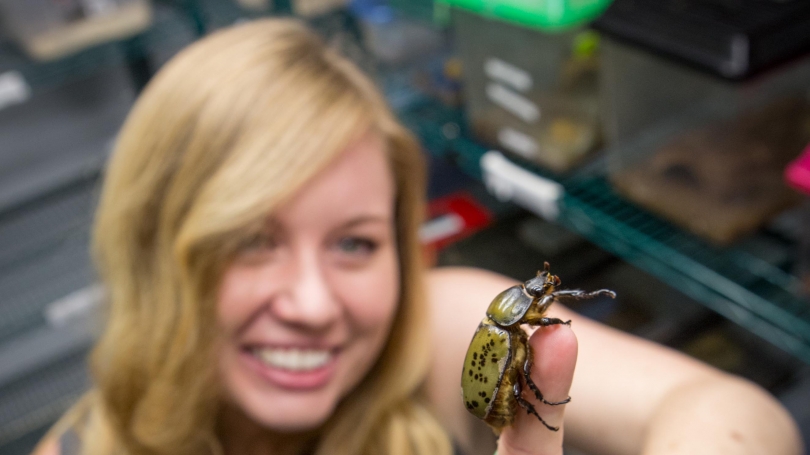
Liz Studer led the conversation at October's Brain Buzz
Did you ever ask why that spider frightened Miss Muffet away? Are insects really creepy? EEES PhD candidate, Liz Studer, led a highly participipatory discussion on culturally normative behaviors around insects at October's Brain Buzz in White River Junction.
Did you ever wonder why little Miss Muffet was frightened by the spider who, after all, only wanted to sit beside her? Exploring cultural normative views of insects was the topic of a recent Brain Buzz event, hosted in collaboration with the GRAD School, the Upper Valley Food Coop, and Vermont Institute of Natural Sciences. A large and varied crowd gathered to discuss what insects were showing up locally, which ones were to be worried about, and which were to be encouraged.
The identity and role of bugs and insects has metamorphosed across cultures, geographies, and history. Spiders are a mediaeval symbol of plague and death, and an Ashanti god incarnate. The cricket is an anthropomorphized talking friend to a compulsively lying wooden puppet, and a great source of protein, delicious fried and salted. And cockroaches, while universally disliked, are behind a booming pharmaceutical industry in China where they’re harvested for their medicinal properties.
Given that there are 950,000 described species of insects, with up to 30million more still to be described, perhaps it’s no wonder that insects and bugs can be, and have been, all things to all people. But contrary to popular belief, the majority of insects are not harmful and nothing to be scared of.
Liz Studer, PhD candidate in Dartmouth’s Ecology, Evolution, Ecosystems and Society program brought the department insect display trays to demonstrate a small part of this massively diverse group. “There are 400,000 species of beetles alone, compared with only 8,000 mammals and their ability to live in every climate on the planet is testament to their biodiversity and is the hallmark reason for conservation,” explained Studer.
Knowing about the different roles they perform is the foundation for understanding ecology. Fewer than 1% of insects are actually “bad”, falling into four broad categories: pests, biters and stingers, and vectors, or those that spread disease. And these are real threats, acknowledges Studer, but the given that more than 99% of them do good, the fear is disproportionate to the threat.
“Knowing about the role they play and the functions they have is critical to biodiversity,” Studer says. “The decline in biodiversity has resulted in an increase in pest groups that no longer have natural predators”. Agricultural research by the USDA has shown that cornfields with higher insect biodiversity have fewer pest species so only when the natural food web has been diminished do pests thrive. That, in addition to pollination services, makes insect biodiversity vital to food security and ecological stability.
The audience included gardeners, educators, and home schoolers who all came away with a better understanding of the importance of insects and bugs. As to why Miss Muffet ran away, perhaps she was just conforming to cultural norms.
If you’re intrigued by Brain Buzz, everone is welcome to our next event to be held Wednesday, November 30 at 6pm. We’ll be hosting a world climate exercise, so come upstairs at the Upper Valley Food Coop in White River Junction to test out your climate negotiation skills, and learn how policy and science intersect.